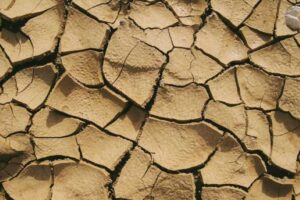
The government’s plan to double farmers’ income by 2022 remains unmet. Data from the ministry of statistics and programme implementation shows that average monthly agricultural income rose from ₹6,426 in 2012–13 to ₹10,218 in 2018–19. Adjusted for inflation, this increase is modest. On an international scale, most Indian farmers remain below the poverty threshold of $3 per day.
The 14-volume Doubling Farmers’ Income report had identified multiple levers to raise income—climate change mitigation being a critical one. Yet, climate-related crop losses continue to undermine income growth, calling for immediate policy recalibration.

Climate change is eroding agricultural productivity through erratic rainfall, extreme temperatures, and more frequent droughts and floods. The 2021 Economic Survey estimated annual yield declines of 15–18% for rainfed crops and 4–6% for irrigated crops due to climate-related stress. The India Meteorological Department reported a 9% rainfall deficit between October and December 2023, followed by a 33% shortfall in early 2024.
Monsoon irregularities have disrupted reservoir levels and rabi output. By February 2025, 14% of the country faced drought, with 9% classified as extreme (Standardised Precipitation Index, 2025). The mean temperature touched 25.75°C in 2024 — 0.65°C above the 1991-2020 baseline. Extreme weather in 2021 caused agricultural losses worth over ₹25,000 crore (CSE, 2022). Such disruptions now shape farm economics across India with increasing regularity.
READ I Income Tax Bill: Start-ups may lose tax relief
Structural costs of climate change
Climate change is projected to reduce net agricultural incomes in India by 3–26% by century-end. Without mitigation, revenue losses could range from 12% to 40% (Nagendiran & Sathya, 2024). A 24-hour heat exposure of 40°C can reduce maize yields by up to 12%, relative to the ideal 29°C growing condition (Carleton et al., 2017). These declines threaten not only livelihoods but also national food security and broader economic growth. Given that agriculture remains the principal employer, ignoring the climate-farm income linkage is not an option for a country aspiring to become a developed nation.
To protect farm incomes from climate volatility, policy must integrate climate-related losses into agricultural income assessments. The way forward includes promoting climate-smart agriculture, expanding access to finance, and improving market infrastructure. Existing platforms like the National Mission for Sustainable Agriculture offer a starting point, but implementation has been weak. A 2017 CAG audit revealed underutilisation of NMSA funds due to bureaucratic delays and lack of integration with related schemes such as Soil Health Management and Micro-Irrigation.

While some farmers have adopted double-cropping or drought-resilient methods, these remain isolated efforts. Financial constraints and limited awareness hinder widespread adoption. Most smallholders — who dominate Indian agriculture — lack the resources to invest in climate-resilient practices. Group farming offers a promising path, enabling risk-sharing and resource pooling to improve access to adaptive technologies. This requires dedicated training and capacity-building, including climate-specific modules for farmers.
Insurance remains central to climate risk mitigation, but coverage under the Pradhan Mantri Fasal Bima Yojana (PMFBY) has been shrinking. Between 2016 and 2022, enrolment dropped by over 40%. A NITI Aayog report in 2019 attributed this to poor awareness and the exclusion of tenant farmers. Reforms must include automatic enrolment, simplified claims, and climate-indexed payouts. These steps can restore trust and offer financial buffers against weather-induced shocks.
Building institutions for climate resilience
Meeting the farmers’ income target requires institutional reform as much as financial outlays. An inter-agency committee should be set up to monitor climate change-linked agricultural losses and recommend timely interventions. This committee must include representatives from the Indian Council of Agricultural Research (ICAR), IMD, state agriculture departments, and farmer organisations. It should track crop losses, input cost escalations, and yield gaps caused by climate stress, and formulate region-specific responses.
Such a framework must also promote localised adaptation — such as cultivating drought-tolerant millets or flood-resistant rice varieties — through women-led Self-Help Groups. Farmer Producer Organisations can be empowered to pool resources for large-scale adoption of climate-resilient inputs. Farmer Field Schools should be revitalised to train cultivators in soil moisture conservation, methane-reducing rice practices, and other climate-smart techniques.
Extending protection to the vulnerable
Most policy measures overlook tenant farmers and sharecroppers, who often lack formal land titles. Insurance and adaptation support must be extended to these groups. Coverage should be linked to a Climate Registry that tracks vulnerability at the household level. In parallel, targeted strategies for low-income agricultural and informal sector households must be developed. As these groups bear the brunt of climate impact, inclusive technological and financial interventions are essential.
India’s aspiration to become a developed nation by 2047 cannot rest on the back of climate change-vulnerable agriculture. Doubling farmers’ income is no longer just a numerical goal — it is a socio-economic imperative requiring climate justice, institutional coordination, and community agency. The emphasis must shift from short-term subsidies and MSPs to long-term resilience.
Innovations like Agrivoltaics which combine solar panels with crop cultivation can offer dual returns. Institutionalising loss tracking, expanding access to climate-smart tools, and empowering FPOs can help turn farmers from passive victims into active climate stewards. Achieving this transformation is essential — not just to meet an income target, but to secure India’s agricultural future.
Dr Deepa Palathingal is an Assistant Professor of Economics at CHRIST University, Delhi NCR.
